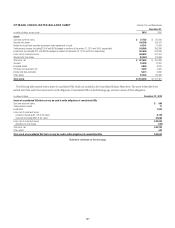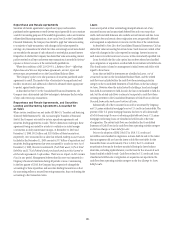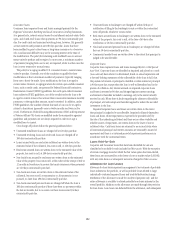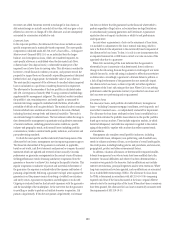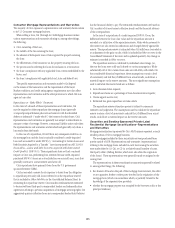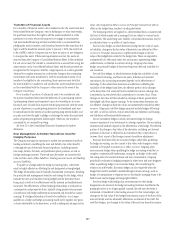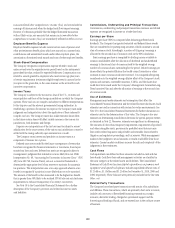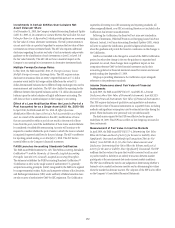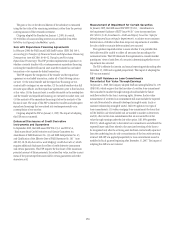Citibank 2010 Annual Report Download - page 168
Download and view the complete annual report
Please find page 168 of the 2010 Citibank annual report below. You can navigate through the pages in the report by either clicking on the pages listed below, or by using the keyword search tool below to find specific information within the annual report.166
the mortgage loan’s compliance with applicable federal, state and •
local laws;
whether the mortgage loan was originated in conformity with the •
originator’s underwriting guidelines; and
the detailed data concerning the mortgage loans that was included on the •
mortgage loan schedule.
In the event of a breach of its representations, Citi may be required either
to repurchase the mortgage loans with the identified defects (generally at
unpaid principal balance plus accrued interest) or indemnify the investors
for their losses.
S&B has received only a small number of claims based on
breaches of representations relating to the mortgage loans in these
securitization transactions.
Goodwill
Goodwill represents the excess of acquisition cost over the fair value of
net tangible and intangible assets acquired. Goodwill is subject to annual
impairment tests, whereby Goodwill is allocated to the Company’s reporting
units and an impairment is deemed to exist if the carrying value of a
reporting unit exceeds its estimated fair value. Furthermore, on any business
dispositions, Goodwill is allocated to the business disposed of based on the
ratio of the fair value of the business disposed of to the fair value of the
reporting unit.
Intangible Assets
Intangible assets—including core deposit intangibles, present value
of future profits, purchased credit card relationships, other customer
relationships, and other intangible assets, but excluding MSRs—are
amortized over their estimated useful lives. Intangible assets deemed to
have indefinite useful lives, primarily certain asset management contracts
and trade names, are not amortized and are subject to annual impairment
tests. An impairment exists if the carrying value of the indefinite-lived
intangible asset exceeds its fair value. For other Intangible assets subject
to amortization, an impairment is recognized if the carrying amount is not
recoverable and exceeds the fair value of the Intangible asset.
Other Assets and Other Liabilities
Other assets include, among other items, loans held-for-sale, deferred tax
assets, equity-method investments, interest and fees receivable, premises and
equipment, end-user derivatives in a net receivable position, repossessed
assets, and other receivables.
Other liabilities includes, among other items, accrued expenses and
other payables, deferred tax liabilities, end-user derivatives in a net payable
position, and reserves for legal claims, taxes, restructuring reserves, unfunded
lending commitments, and other matters.
Repossessed Assets
Upon repossession, loans are adjusted, if necessary, to the estimated fair value
of the underlying collateral and transferred to repossessed assets. This is
reported in Other assets, net of a valuation allowance for selling costs and net
declines in value as appropriate.
Securitizations
The Company primarily securitizes credit card receivables and mortgages.
Other types of securitized assets include corporate debt instruments (in cash
and synthetic form) and student loans.
There are two key accounting determinations that must be made relating
to securitizations. In cases where the Company originated or owned the
financial assets transferred to the securitization entity, it determines whether
that transfer is considered a sale under U.S. Generally Accepted Accounting
Principles (GAAP). If it is a sale, the transferred assets are removed from
the Company’s Consolidated Balance Sheet with a gain or loss recognized.
Alternatively, if the Company determines that the transfer is a financing
rather than a sale, the assets remain on the Company’s Consolidated
Balance Sheet with an offsetting liability recognized in the amount of
proceeds received.
In addition, the Company determines whether the securitization
entity would be included in its Consolidated Financial Statements. If the
securitization entity is a VIE, the Company consolidates the VIE if it is the
primary beneficiary.
For all other securitization entities determined not to be VIEs in which
Citigroup participates, a consolidation decision is based on who has voting
control of the entity, giving consideration to removal and liquidation rights
in certain partnership structures. Only securitization entities controlled by
Citigroup are consolidated.
Effective January 1, 2010, upon adoption of SFAS 166/167, Citi first
makes a determination as to whether the securitization entity would be
consolidated. Second, it determines whether the transfer of financial assets
is considered a sale under GAAP. Furthermore, former qualifying special
purpose entities (QSPEs) are now considered VIEs and are no longer exempt
from consolidation. The Company consolidates VIEs when it has both:
(1) power to direct activities of the VIE that most significantly impact the
entity’s economic performance and (2) an obligation to absorb losses or
right to receive benefits from the entity that could potentially be significant
to the VIE.
Interests in the securitized and sold assets may be retained in the form of
subordinated interest-only strips, subordinated tranches, spread accounts,
and servicing rights. In credit card securitizations, the Company retains a
seller’s interest in the credit card receivables transferred to the trusts, which
is not in securitized form. Prior to January 1, 2010, when the securitization
trusts were not consolidated, the seller’s interest was carried on a historical
cost basis and classified as Consumer loans. Retained interests in securitized
mortgage loans and student loans were classified as Trading account
assets, as were a majority of the retained interests in securitized credit
card receivables.
Debt
Short-term borrowings and long-term debt are generally accounted for at
amortized cost, except where the Company has elected to report certain
structured notes at fair value.



